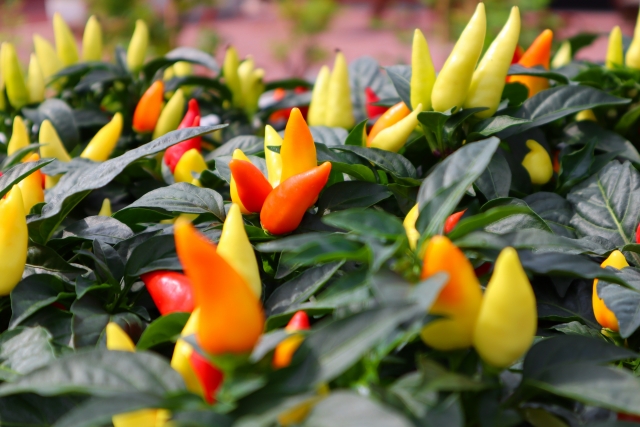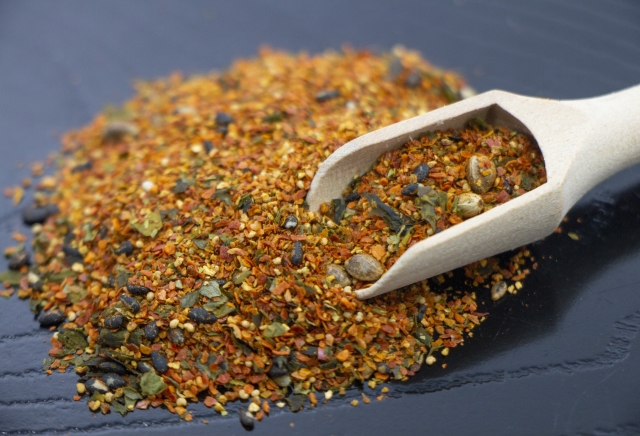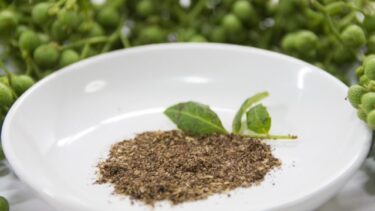It is a blended spice unique to Japan that contains 7 kinds of ingredients including chili peppers.
Originally, it was sold at stores in different amounts according to the taste of the customer. Nowadays, the formulas are sold, but there are still specialty stores that sell in the old-fashioned way. There are differences in the raw materials used by each manufacturer.
It is an indispensable seasoning for noodles such as udon and soba, hot pot dishes such as mizutaki and yudofu, and simmered dishes such as kinpira and meat potatoes.
What is Shichimi pepper and can I eat it?
Materials of Shichimi pepper
Here are three types of recipes.
- Recipe No.1: Chili pepper, Japanese pepper, hemp seed, black sesame, chenpi, roasted chili pepper, poppy seed
- Recipe No.2: Chili pepper, Japanese pepper, hemp seed, black sesame, chenpi, shiso, ginger
- Recipe No.3: Chili pepper, Japanese pepper, hemp seeds, black sesame, white sesame, ao-shiso, green laver
The ingredients will be explained in the next section.
| Gluten-free | Low-gluten | Wheat-free | Low FODMAPs | |
| for Vegetarian |
| Food supermarket | Convenience store | Drug store |
Shichimi pepper contains 7 kinds of botanical ingredients
Shichimi pepper was born 400 years ago.

By adding other ingredients to the chili pepper, the spiciness was reduced and the taste and aroma became more delicious, making it popular as a seasoning. It is still used today as an indispensable seasoning for Japanese food.
There are many dishes that use Shichimi pepper. It is often used for warm udon and soba. Also, in hot pot dishes such as mizutaki and yudofu, we eat them over the ingredients you. In addition, Shichimi pepper is also used in standard Japanese food such as meat potatoes and kinpira.
On the other hand, Shichimi peppers are rarely used in cold dishes.
There are several recipes for Shichimi pepper. That’s because different stores have different formulations.
Of the seven ingredients, pepper, sansho (Japanese pepper), hemp seeds, and black sesame are commonly used, but the remaining three ingredients vary depending on the recipe.
The raw materials used are as follows.

Chili pepper
It is a dried chili pepper and has a very strong spiciness.
Sansho (Japanese pepper)
Dried skin of ripe fruit of a Rutaceae plant called Sansho. It has a strong spiciness and a refreshing aroma. It has the effect of enhancing gastrointestinal function and is also used as a Chinese herbal medicine.
Hemp seeds
Dried hemp seeds, roasted and fragrant, are used for shichimi peppers. In addition to being used as food for small birds, it is also used in Chinese medicine as a laxative.
Black sesame
Black sesame is one of the sesame varieties, and the color of the seed coat is black.
Chenpi
Ripe orange peel is dried over a long period of time. It has a refreshing aroma and bitterness of citrus. It has the effect of enhancing gastrointestinal function and soothing cough, and is also used as a Chinese herbal medicine.
Grilled chili pepper
Roasted chili peppers, which have a milder spiciness and more aroma than chili peppers.
Poppy seeds
Poppy seeds that become fragrant when roasted. It is used in various dishes.
Shiso
The leaves of Labiatae plants are purple and have a unique scent. This leaf is dried and crushed and used for Shichimi pepper.
Ginger
It is a ginger stalk and has a strong pungency and aroma. It is also used as a Chinese herbal medicine because it has the effect of improving blood circulation and warming the body.
White sesame
White sesame is one of the sesame varieties, and the color of the seed coat is white.
Ao-shiso
The leaves of Labiatae plants are green and have a unique scent. This leaf is dried and crushed and used for Shichimi pepper.
Green laver
A general term for edible green seaweed, it is made by drying and crushing Monostroma nitidum, Anaaosa, Sujiaonori, etc.
Try to eat Shichimi pepper!
How much ?
$ 4.3~per 100g
Where can I get Shichimi pepper?
You can buy it at all food supermarkets and convenience stores in Japan. If you want your own Shichimi pepper, buy it at one of the following specialty stores that has been around for over 300 years.

Yagenbori
It is a store that offers the No. 1 recipe for Shichimi peppers, located in Asakusa, Tokyo. Founded in 1625.
Yawataya Isogoro
It is a shop that offers Shichimi pepper of recipe No. 2, and is located in front of Zenkoji Temple in Nagano City. Founded in 1736.
Shichimiya Honpo
It is a shop that offers Shichimi pepper of recipe No. 3, and is located on the approach to Kiyomizu-dera Temple in Kyoto City. It was founded around 1655.
Precautions when using Shichimi pepper
Shichimi pepper is a gluten-free, animal-free seasoning, so most people can eat it with confidence.
Japanese writer’s comment for Shichimi pepper
Shichimi pepper, along with soy sauce, is a seasoning that is provided in many restaurants.
Udon restaurants, sobaya restaurants, and gyudon restaurants always have them on the table, and many Japanese restaurants bring you a small bottle of shichimi when you order a warm menu.

First of all, please experience what it is like at the restaurant. If you like it, you can buy it anywhere in Japan.



